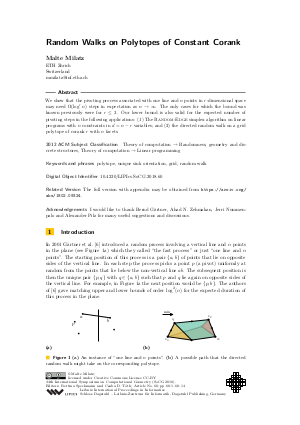Random Walks on Polytopes of Constant Corank
Author Malte Milatz
-
Part of:
Volume:
34th International Symposium on Computational Geometry (SoCG 2018)
Part of: Series: Leibniz International Proceedings in Informatics (LIPIcs)
Part of: Conference: Symposium on Computational Geometry (SoCG) - License:
 Creative Commons Attribution 3.0 Unported license
Creative Commons Attribution 3.0 Unported license
- Publication Date: 2018-06-08
File

PDF
LIPIcs.SoCG.2018.60.pdf
- Filesize: 0.6 MB
- 14 pages
Document Identifiers
Subject Classification
Keywords
- polytope
- unique sink orientation
- grid
- random walk
Metrics
- Access Statistics
-
Total Accesses (updated on a weekly basis)
0PDF Downloads0Metadata Views
Abstract
We show that the pivoting process associated with one line and n points in r-dimensional space may need Omega(log^r n) steps in expectation as n -> infty. The only cases for which the bound was known previously were for r <= 3. Our lower bound is also valid for the expected number of pivoting steps in the following applications: (1) The Random-Edge simplex algorithm on linear programs with n constraints in d = n-r variables; and (2) the directed random walk on a grid polytope of corank r with n facets.
Cite As Get BibTex
Malte Milatz. Random Walks on Polytopes of Constant Corank. In 34th International Symposium on Computational Geometry (SoCG 2018). Leibniz International Proceedings in Informatics (LIPIcs), Volume 99, pp. 60:1-60:14, Schloss Dagstuhl – Leibniz-Zentrum für Informatik (2018)
https://doi.org/10.4230/LIPIcs.SoCG.2018.60
BibTex
@InProceedings{milatz:LIPIcs.SoCG.2018.60,
author = {Milatz, Malte},
title = {{Random Walks on Polytopes of Constant Corank}},
booktitle = {34th International Symposium on Computational Geometry (SoCG 2018)},
pages = {60:1--60:14},
series = {Leibniz International Proceedings in Informatics (LIPIcs)},
ISBN = {978-3-95977-066-8},
ISSN = {1868-8969},
year = {2018},
volume = {99},
editor = {Speckmann, Bettina and T\'{o}th, Csaba D.},
publisher = {Schloss Dagstuhl -- Leibniz-Zentrum f{\"u}r Informatik},
address = {Dagstuhl, Germany},
URL = {https://drops.dagstuhl.de/entities/document/10.4230/LIPIcs.SoCG.2018.60},
URN = {urn:nbn:de:0030-drops-87730},
doi = {10.4230/LIPIcs.SoCG.2018.60},
annote = {Keywords: polytope, unique sink orientation, grid, random walk}
}
Author Details
References
-
Andrei Z. Broder, Martin E. Dyer, Alan M. Frieze, Prabhakar Raghavan, and Eli Upfal. The worst-case running time of the random simplex algorithm is exponential in the height. Inf. Process. Lett., 56(2):79-81, 1995.

-
Stefan Felsner, Bernd Gärtner, and Falk Tschirschnitz. Grid orientations, (d,d+2)-polytopes, and arrangements of pseudolines. Discrete & Computational Geometry, 34(3):411-437, 2005.

-
Oliver Friedmann, Thomas Dueholm Hansen, and Uri Zwick. Subexponential lower bounds for randomized pivoting rules for the simplex algorithm. In Proceedings of the 43rd ACM Symposium on Theory of Computing (STOC), pages 283-292, 2011.

-
Bernd Gärtner, Martin Henk, and Günter M. Ziegler. Randomized simplex algorithms on klee-minty cubes. Combinatorica, 18(3):349-372, 1998.

-
Bernd Gärtner, Walter D. Morris, Jr., and Leo Rüst. Unique sink orientations of grids. Algorithmica, 51:200-235, 2008.

-
Bernd Gärtner, József Solymosi, Falk Tschirschnitz, Pavel Valtr, and Emo Welzl. One line and n points. Random Structures &Algorithms, 23(4):453-471, 2003 (preliminary version at STOC 2001).

-
Branko Grünbaum. Convex polytopes. Springer, New York, 1967/2003.

-
Kathy Williamson Hoke. Completely unimodal numberings of a simple polytope. Discrete Applied Mathematics, 20(1):69-81, 1988.

-
Volker Kaibel, Rafael Mechtel, Micha Sharir, and Günter M. Ziegler. The simplex algorithm in dimension three. SIAM Journal on Computing, 34(2):475-497, 2005.

-
Gil Kalai. A subexponential randomized simplex algorithm. In Proc. 24th ACM Symposium on Theory of Computing, pages 475-482, 1992.

-
Jiří Matoušek and Tibor Szabó. Random edge can be exponential on abstract cubes. Advances in Mathematics, 204(1):262-277, 2006.

-
Peter McMullen. On the upper-bound conjecture for convex polytopes. Journal of Combinatorial Theory, Series B, 10(3):187-200, 1971.

-
Malte Milatz. Directed random walks on polytopes with few facets. Electronic Notes in Discrete Mathematics, 61:869-875, 2017. The European Conference on Combinatorics, Graph Theory and Applications (Eurocomb '17).

-
Julian Pfeifle and Günter M. Ziegler. On the monotone upper bound problem. Experimental Mathematics, 13(1):1-12, 2004.

-
Francisco Santos. A counterexample to the Hirsch Conjecture. Annals of Mathematics, 176:383-412, 2012.

-
Falk Tschirschnitz. LP-related properties of polytopes with few facets. PhD thesis, ETH Zürich, 2003.

